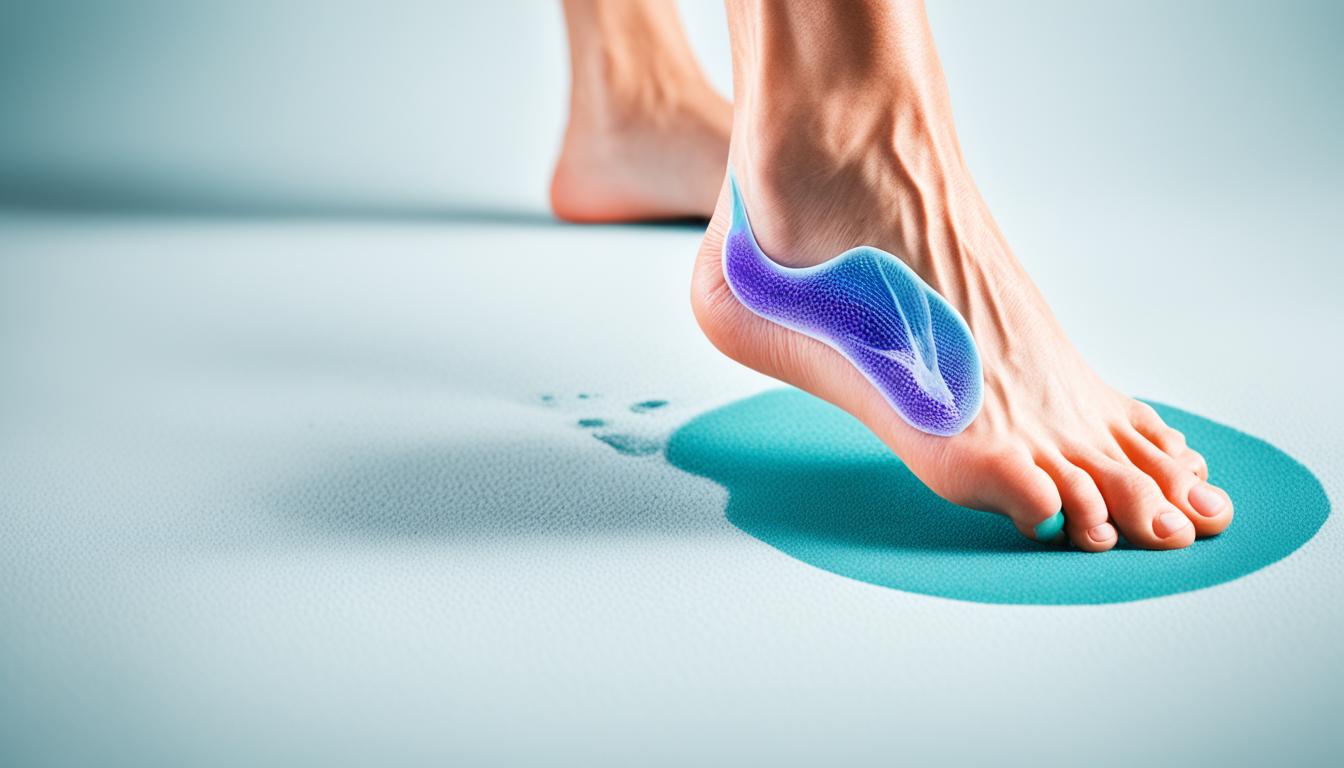Metatarsalgia is a foot issue that causes pain and swelling in the foot’s ball. It mainly affects the area between the toes and the foot’s arch. People with this condition often find their day-to-day life affected.
It’s important to know metatarsalgia’s signs, what causes it, and how to treat it. This knowledge is key to easing foot pain. We’ll look at the symptoms, causes, diagnosis, and how stem cell therapy can help.
Key Takeaways:
- Metatarsalgia is a foot condition characterized by pain and inflammation in the ball of the foot.
- Causes of metatarsalgia include factors such as hypermobile 1st ray, intensive physical activity, high-heeled footwear, high-arched foot, toe deformities, and more.
- Symptoms of metatarsalgia include pain in the ball of the foot, feeling like there’s a pebble at the base of the foot, callus formation, and swelling of the joints near the toes.
- Diagnosis of metatarsalgia usually involves physical examination and diagnostic tests such as X-rays, ultrasound, and MRI scan.
- Treatment options for metatarsalgia range from conservative methods like applying ice, taking medications, changing footwear, and using metatarsal pads to surgery in more severe cases.
- Stem cell therapy is a promising treatment option for metatarsalgia, using stem cells to promote healing and regenerate damaged tissues in the foot.
Causes and Risk Factors of Metatarsalgia
Metatarsalgia is a foot condition caused by many factors. It’s important to know these causes and risk factors. This knowledge helps prevent and manage metatarsalgia.
Causes of Metatarsalgia
The following factors can cause metatarsalgia:
- Hypermobile 1st ray
- Intensive physical activity in sports
- High-heeled footwear
- High-arched foot
- Certain toe deformities
- Plantar plate tear
- Weak toe muscles
- Tight Achilles tendon
- Excess body weight
- Cycling with ill-fitting shoes
- Running in minimalist shoes
These factors increase pressure on the metatarsal heads. This causes pain and inflammation.
Risk Factors of Metatarsalgia
Certain risk factors can make metatarsalgia more likely. These include:
- Obesity
- Certain foot structures
- Certain foot mechanics
Knowing these risk factors helps people take steps to lower their risk.
| Causes | Risk Factors |
|---|---|
| Hypermobile 1st ray | Obesity |
| Intensive physical activity in sports | Certain foot structures |
| High-heeled footwear | Certain foot mechanics |
| High-arched foot | |
| Certain toe deformities | |
| Plantar plate tear | |
| Weak toe muscles | |
| Tight Achilles tendon | |
| Excess body weight | |
| Cycling with ill-fitting shoes | |
| Running in minimalist shoes |
Symptoms and Diagnosis of Metatarsalgia
Metatarsalgia causes pain in the foot’s ball. Symptoms include:
- Pain in the ball of the foot hurts like a deep bruise. It worsens when you stand or walk, especially barefoot.
- Some might feel like there’s a pebble under their foot. This can make walking uneven and unsteady.
- It can cause calluses on the foot. Calluses are thick, hard skin patches that form due to pressure and friction.
- Toes may swell due to inflammation in the metatarsal joints. This adds to the pain and discomfort.
Doctors start by asking about your symptoms and daily life. They want to know when and how much you hurt, and if anything makes it better or worse. Then, they check your foot for swelling, deformities, or other issues.
To be sure it’s metatarsalgia and not something else, they might run some tests. These could include:
- X-rays look for fractures, arthritis, or other problems in the bones.
- Ultrasounds take images of the foot’s soft tissues. This helps spot any damage to ligaments or tendons.
- MRI scans give a detailed picture of the foot’s inside. They can show stress fractures or soft tissue injuries.
By putting together your symptoms, the foot exam, and the test results, doctors can diagnose metatarsalgia. Then, they can choose the right treatment for you.
Treatment Options for Metatarsalgia
The first step in treating metatarsalgia is often non-surgical. This usually means trying things that don’t involve an operation. Ice, pain medicine, and new shoes that fit better are the main ones. Pressure bandages and pads under the foot can spread the weight, making it feel better.
It is crucial for heavy people to lose weight. Less weight means less pressure on the feet. Also, always wear shoes; walking barefoot makes the pain worse.
If non-surgical ways don’t work, surgery might be the next step. There are different kinds of surgeries available, like getting rid of hard skin or fixing toe problems. Choosing the right treatment needs the help of a doctor.
Stem cell therapy is a new and exciting treatment for this foot problem. It uses cells to fix the injury, offering a lasting solution. This can make the foot work better for people suffering from metatarsalgia.

